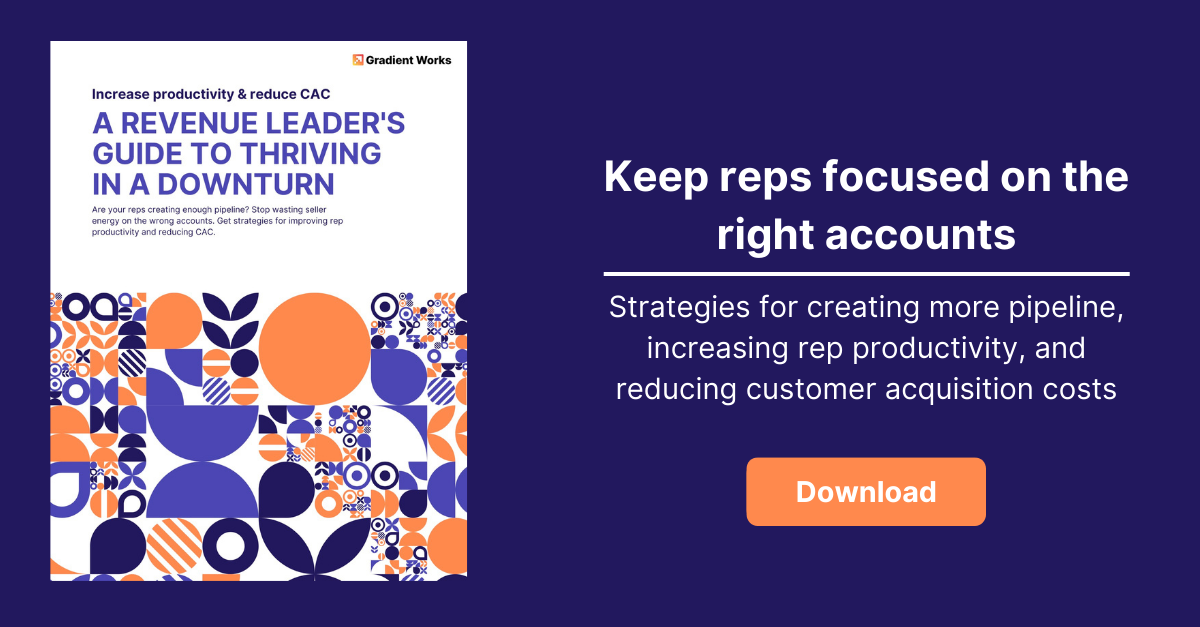Q1 was tough for sales teams- opportunities were harder to come by, there were fewer meetings, and even fewer deals. How does that happen when your reps have been focused on doing as much activity as possible? Chasing basic activity metrics often creates a lot of non-productive behavior. Getting the most from your reps in Q2 requires a focus on quality, not quantity. Focusing on these 4 sales productivity metrics will build positive rep behaviors and healthy pipeline.
1. Book engagement rate
A rep’s book engagement rate measures how many accounts in a rep’s book have been contacted during a particular time period. How thoroughly is a rep working their book? You may have different expectations for different teams, depending on the size and composition of a rep’s book, but you want to ensure that reps are engaging enough high-potential accounts on a regular basis to generate pipeline.
Under engaging
Reps who have a low engagement rate with their account book or territory could mean they are over capacity and have too many accounts to reasonably work. Giving reps a smaller, more focused book of accounts allows reps to engage more of, or even all, of their accounts, making sure no one falls through the cracks. There are other reasons for a rep to not engage with a majority of their accounts that can be flushed out during coaching, including a lack of good contact info, a need to re-train, lack of motivation. No matter the reason, you can reduce the number of accounts in a rep’s book by retrieving and redistributing them to other reps and/or allowing reps to return accounts that cannot be worked or have been worked to completion.
Over engaging
By the same logic, your rep may be over-engaging accounts because they have too few accounts. Another more likely scenario is that your rep is “spraying and praying” to reach an activity number - trying to just get in enough activities to hit their goals. To reach that activity number, a rep may be sending out generic cadences in hopes of any kind of response or, worse, spamming accounts with many too many touchpoints because they don’t have enough accounts to work. Looking for the ideal number of accounts for your reps? We’ve got a calculator for that.
2. Number of contacts per account
According to Ebsta & Pavilion, the number of stakeholders in a deal increased to 10 in 2022. Your single inbound contact is not enough anymore to get deals across the finish line. Reps will need to multi-thread and build value with multiple stakeholders. is why a smaller, more focused book of accounts may help reps focus. Multi-threading and personalization take time. When a rep is over capacity and needs to engage multiple stakeholders, they tend to favor a spray and pray approach, which can actually make outbound prospecting more difficult because it creates so much noise. Read more on how to outbound better.
3. Number of prospects that have completed sequences
By reviewing completed sequences, sales reps can see which messages and actions were most successful in moving prospects through the sales funnel. They can analyze the data to identify patterns and trends, such as which email subject lines had the highest open rates or which types of content were most effective in engaging prospects.
For rep productivity, reviewing completed sequences can highlight types of personalization and contacts that are engaged, what channels they respond in, and the pain points to focus on in future cadences.
4. Percentage of SQL to opportunity creation
42% of SQLs become opportunities. (First Page Sage) Reviewing the conversion rate indicated the overall effectiveness of the sales process. Starting with lead qualification, a lower % of opportunity creation could indicate overly strict criteria. Second, the percentage and amount of time from SQL to opportunity highlight the efficiency of the sales process as well as ROI and forecasting future sales.
Sales teams everywhere are being asked to do more, and many are adjusting targets for the next quarter to play catch up. Teams working with static account distributions may not be able to adjust their reps’ books in time to affect pipeline. If that’s your team, take a look at dynamic book management. Distribute accounts in minutes, not months, and get your quota attainment goals back on track. Tour dynamic books.





